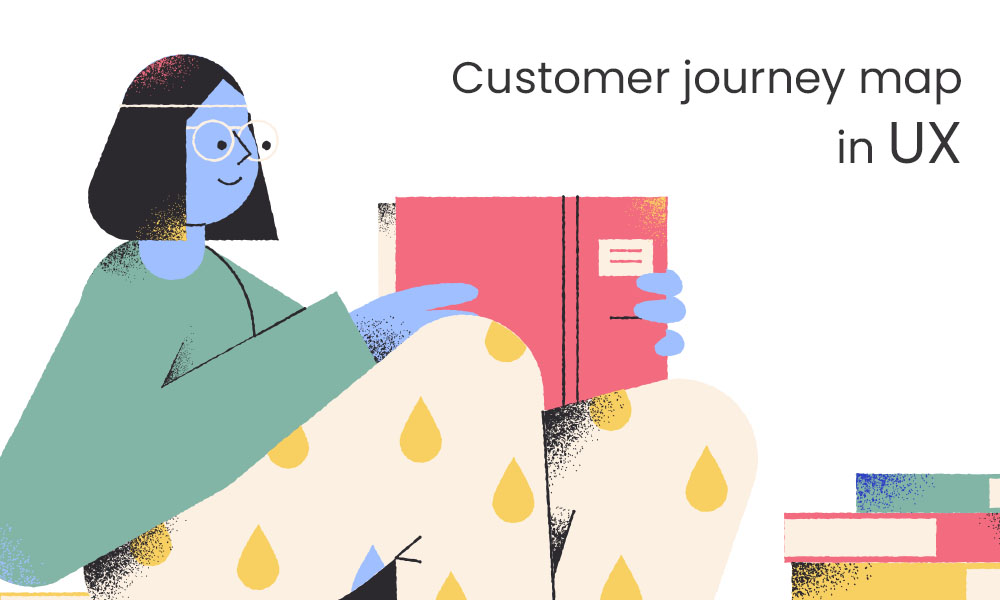Customer journey maps are one of the most important tools in UX design. They help designers and entrepreneurs to understand the customer journey and empathize with their customers.
We understand that there has been some confusion about the name ‘journey map’ – but if you just think of it as a map it will be much easier to understand what this tool is for. When we create a customer journey map we map out all the steps in the customer’s actual journey and we can then plan out our content based on these steps in order to create a better customer experience.
Basically, A journey map is a visual representation of an experience or process. It usually includes a sequence of steps, possible activities, and what people might need in order to complete them. The main goal of a journey map is to gather input from stakeholders and make sure that everything from start to finish is covered in detail. It also helps you understand what could go wrong for better mitigation or prevention during implementation.
Benefits of user journey mapping
Designing interfaces is one of the most important parts of UX design.
- It’s where the designer decides how users will interact with an app or website.
- User journey mapping helps you understand how your customers take the journey through your product to achieve their goals, and provides insights into how to make that journey as seamless as possible.
- This process will also help you find any areas for improvement or new features to be added to the system.
- A customer-focused approach is essential for ensuring success in today’s business world, and user experience design is a powerful way of achieving this goal.
- A well-thought out user journey map can save time, money and effort down the line. You can use it to cut through development puzzles; clean up old features; prioritize what needs to see from beginning.
KPI tracking in user journey mapping
KPI tracking is a way for companies to measure and analyze their performance in order to identify areas that need improvement. It’s important that these KPIs are carefully selected so that they are aligned with company objectives.
The KPI (Key Performance Indicator) is a measure of success and is important in measuring the performance of a user journey map. It can be used to measure the efficiency and effectiveness of specific processes.
A major challenge faced by UX designers when developing a user journey map is that they do not know what KPIs to track. To avoid this, it is best to keep the following in mind:
- The KPIs should be measurable and quantifiable
- The KPIs should help measure the efficiency and effectiveness of specific processes
- KPIs should align with business goals
Different Types Used for User Journey Mapping
User journey mapping is a very important part of the UX design process. It helps the team to focus on user needs, pain points, and how they can be solved.
The following are different types of user journey mapping techniques that are used in UX design:
User flowcharting – This technique combines sketches with written words to depict user interaction with the product or service over time.
Stakeholder workshop – Stakeholders are brought together to discuss what they know about the users and their needs, as well as discuss how their needs might change over time.
Personas – A persona is a literary device that represents a type of user that has common traits or behaviors. They help designers understand what users need from their products or services, which eventually leads to better designs.
Uber Case Study
The company started in 2009. Uber is the world’s largest ride-sharing firm, operating in more than 70 countries and 400 cities worldwide.
Uber is a transportation network company that provides the ability to request a ride from an individual through an app. The user can then see where the driver is, wait for them, and pay through the app. They offer various service levels which are not available in other transportation systems. These services include UberX (intermediate car), UberXL (larger car), and UberSelect (luxury car).
The company was founded in 2009 by Travis Kalanick and Garrett Camp. Now it operates in over 65 countries around the world with more than 2 million drivers on its platform. The headquarters are located in San Francisco, California.
What Uber Follows in User Journey Mapping?
Uber is a company that created a ride-hailing service. In this section, we will analyze how Uber follows in user journey mapping.
In order to be successful in the transportation business, being able to identify and solve problems is an important factor. For Uber, user experience is a priority, which also leads to its success in the market. For instance, when the company realized that passengers use their apps for different purposes such as booking a ride or checking ETAs for Uber drivers nearby, they introduced different features to cater to their needs and make them more customer-centric.
On-boarding (App User Screen)
The on-boarding process is a crucial part for new users to get acquainted with the product and let them know what they need to do.
It’s important that Uber Follows provides an intuitive and easy-to-use experience for new riders. For example, the app should be able to encourage users with personalized offers and suggestions.
The Uber app has always had an amazing on-boarding process. The new Uber Follows app is no different in that regard. It allows you to know when your car arrives and what the driver’s name is while also providing you with useful information like your driver’s photo, rating, personal details, and more!
Navigation on the Uber app
The Uber app has an experimental navigation system that allows users to follow their journey on the map. The navigation of the Uber app is easy to use and follows a user’s journey from start to finish.
The navigation of the Uber app is straightforward and follows a user’s journey from start to finish. The key features on the home screen are icons for three main functionalities: “Book a ride”, “Your trips”, and “Help”.
A search box at the top of the home screen lets users find their desired destination by typing in an address or location they want to go to. The app then displays all available options in different parts of town for that address or location.
If there aren’t many results found, users can manually type in their desired destination or just use one of their saved destinations that is saved in the location where user wish to reach.
Uber navigation is interactive and lets users know where they are, how long it will take them to get there, what the traffic is like, and alternative routes.
Feedback System
Feedback is an important part of the user journey. It gives the user a sense of accomplishment and helps them to identify what they need to improve on.
Uber has recognized this importance and has created a feedback system. The app asks for feedback points at various points in the journey, like when the driver drops you off or when their ride was cancelled. It also asks for feedback after completing your ride with either five stars or one star.
A feedback system on the Uber app will help in making the user experience more satisfying. The feedback system should not only be present on the end of a journey but it should also be present on the beginning of a journey.
The feedback system is an integral part of any app and it’s especially important in an app like Uber where people don’t know what kind of service they can expect until they have already made their payment.





